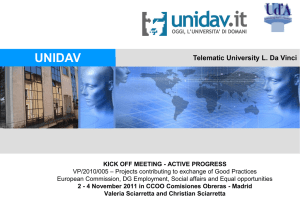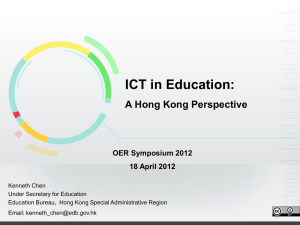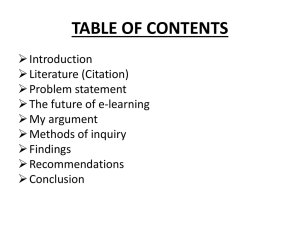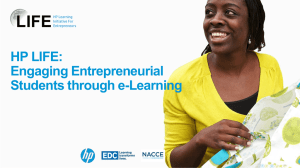Prof M. Anandakrishnan - e
advertisement
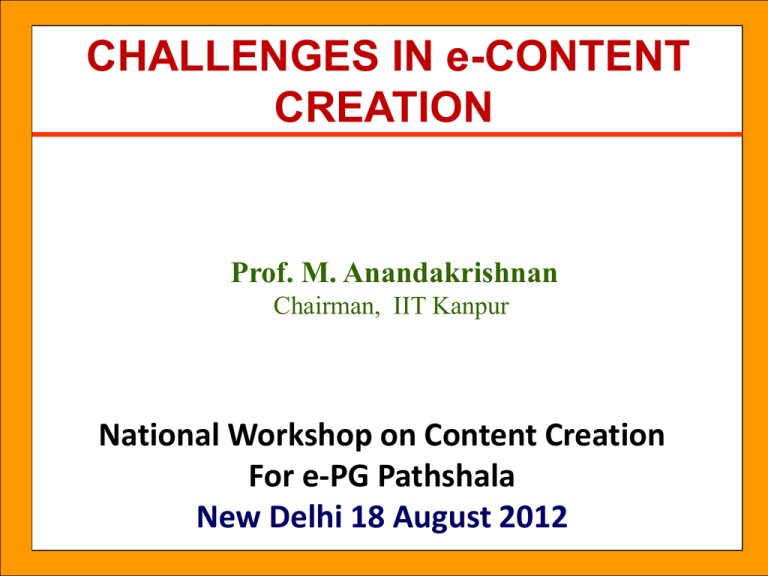
CHALLENGES IN e-CONTENT CREATION Prof. M. Anandakrishnan Chairman, IIT Kanpur National Workshop on Content Creation For e-PG Pathshala New Delhi 18 August 2012 VIRTUAL EDUCATION • Includes aspects of both online and elearning; Is largely web-centric; • Learners may be in or outside classroom; • Uses multimedia devices; • Enables a high level of interaction among learners, teachers, peers and administrators both synchronously and asynchronously E-LEARNING • Electronically supported learning, and teaching; • computer and network-enabled transfer of skills and knowledge; • Web-based learning, • Content is delivered via the Internet, intranet/extranet, audio or video tape, satellite TV, and CD-ROM. ONLINE LEARNING • Application of ICT to enhance distance education; • Enables open learning; • Makes learning activities more flexible; • Enables those learning activities to be distributed among many learning venues. • Affordability is increased Discourse Oriented Education Consists of lectures, laboratory sessions, tutorials followed by homework assignments, quizzes, term papers and examinations or tests. examination on a batchmode of processing. All these processes are becoming increasingly inefficient and expensive. Growth in Conventional Higher Education • Mammoth growth in the number of higher education institutions; • Total enrolment 128.23 lakhs of students in conventional higher education system, 43% are in the faculty of Arts, 19% in Science and 18% in Commerce,; remaining 20% enrolment had been in professional and other courses. Open and Distance Learning Total Enrolment: 42.01 Lakhs IGNOU : 6.97 Lakhs State Open Univ. : 10.80 Lakhs Distance Education Institutions: 24.24 Lakhs GROWING ASPIRATIONS • Increasing number of aspirants due to growing realization about the economic value of education; • Inadequate resources to fully meet all aspirations in the conventional mode. • ODL system can fulfil some of the rising demands. EVOLUTION OF DISTANCE LEARNING • 75 to 100 years old. Correspondance Courses. Mostly Theory Intensive. • Some DEIs have adopted modern technologies • Inadequate internet connectivity and insufficient band widths; ENROLMENT, SUPPORT AND RECOGNITION OF ODL • Enrolment is highest in UG programmes; SOUs, 49.3%; DEIs 45-71%: Certificate/ Diploma Programmes: Open Universities have higher enrolments; e.g. IGNOU – 34.99%, YCMOU – 34.84% and BAOU – 71.95%. • PG programmes in the ODL: 15-20% in SOUs and around 30% in DEIs. • Ph.D students 954: in ODL prior to UGC Ban • (IGNOU 580-Ph.D. and 38- M.Phil students up to January 2011) • Women: about 40%; Rural students about 52%; • SC enrolled : 13.6% in SOUs and around 20% in DEIs. DEFICIENCIES • Study centres are mostly poorly manned with some exceptions • No credible system of accreditation for ODL • Employer Recognition for fresh degrees is lukewarm. • Adoption of e-learning provides hope POPULAR MYTHS ABOUT e-LEARNING e-learning saves money. e-learning for anyone, anywhere, any time. e-learning is what net generation wants. e-learning replaces face-to-face learning. e-learning can replace teachers. e-learning is about speed. e-learning is about flexibility. e-learning is about multitasking. e-learning is facilitated, not taught. e-CONTENT DEVELOPMENT • The e-content should be beyond syllabi. Neither simple digitization of text nor routine video lectures. • should be holistic in nature and include such aspects as the socio-economic, emerging trends in the area, relationship with other disciplines and so on. • should not be merely to cover the syllabi and not treated as a means of coaching for examinations. • the theoretical aspects should be presented with a judicious combination of lectures, graphics, animation, illustration and power points. • Where laboratory and workshop are involved the econtent should be demonstrative as well as participatory. ONLINE DELIVERY • Adoption of latest course delivery methods such as the internet, streaming video, video conferencing, virtual labs, instructional design, interactive content, CD, video tapes, on-the-job training, etc, to create a learning experience. • Should be self-instructional packages with an integrated multi-media approach, and incorporation of interactive communication technologies. • Such a transformation will need rigorous set of standards for curricular framework, contents, delivery mechanisms, assessment, accreditation and certification. SCALE OF TASK • Hundreds of UG and PG degree programmes and subjects associated with them. One semester programme involves 40 lectures per subject. Nearly 4 modules/submodules of e-content; total 160 modules/submodules. Plus illustrative/ participatory labs/ workshops. All with animations, graphics, voice, music, power point, etc., Needs subject expert working with content designer. (eg. ILLL/ DU) • A six semester discipline involves 30 subjects with 4800 modules. • Massive task with large number subject experts and technicians with the availability of necessary technical infrastructure. STANDARDS • These standards relate to facilities such as : o o o o o o e-mail 24 turn-around time, Easy (click) access to instructor e-mail; Technical Standards for the Website; Standards for Instructor qualification; virus protection training; and technical support to the students. • Curriculum approval, Evaluation of Course content and Course Approval should be done by experts designated Features of MIT OCW of Courses – UG and PG; Syllabi; •Lecture Notes in PDF form Hand Written and Blackboard Captured • Video Lectures; course meeting schedules; Names of Lecturers and tutors •Assignments and solutions; Exams; question papers; solutions. •Text books, study guides, problem sets •Academic behavior and honesty • List FAILURE OF UK e-UNIVERSITY • UK e–University project started in 2002 under the holding company, HEFCE and the DfES was wound up IN 2004 by HEFCE, having spent £50 million of public money but having succeeded only in attracting 900 students against a target of 5600with implications for future for e-learning and e-Universities • Took a supply-driven rather than demand led approach. • Inability to work in effective partnership with the private sector, to meet its targets, aims, and objectives. Failed to attract significant private investment. UKeU Insufficient market research to assess either the level of demand or the nature of the demand and the type of e-learning required. No understanding of consumer demand. Focused too much on providing an integrated e–learning platform. Over-confident presumption about the scale of the demand for wholly Internet based e-learning. - (Report of House of Commons Education and Skills Committee – 2005) MASSIVE ONLINE OPEN COURSEWARE • MOOC is less than a year old; likely to be game changer in Higher Education; • Beyond ten year old OCW; Crucial Innovation is Online Grading and Certification; •Knowledge is Public Good •IVY League Institutions involved in content creation; •Can be a substitute and supplement for conventional university education; •May destabilize economic basis for higher education CONCLUSION • Not to be carried away by Hypes • Sustain the holistic nature of education and idea of university • Avoid fragmentation of knowledge • Develop e-learning system more for elaboration of topics, visual illustration of difficult concepts, supplemental learning etc. Rather than for fresh degrees. • Avail free portals such as MITx, iLABS and SEE for engineering subjects; Develop similar portals for science and humanities THANK YOU



